tow Lancia Ypsilon 2012 Owner handbook (in English)
[x] Cancel search | Manufacturer: LANCIA, Model Year: 2012, Model line: Ypsilon, Model: Lancia Ypsilon 2012Pages: 307, PDF Size: 13.3 MB
Page 117 of 307

OPERATION WITH TRAILER
The operation of the sensors is automatically
deactivated when the trailer's electric plug
is inserted in the car's tow hook socket. The
sensors are automatically enabled again when the
trailer's cable plug is removed.
IMPORTANT If you wish to leave the tow hook
fitted when there is no trailer, it is advisable to go
to a Lancia Dealership to have the system updated
because the tow hook could be detected as an
obstacle by the centre sensors.
GENERAL WARNINGS
During parking manoeuvres, pay the utmost
attention to any obstacles that could be located
above or below the sensors.
Under certain circumstances close objects located
in front of or behind the car may not be detected
and could therefore cause damage to the car or
be damaged themselves.
The following conditions may influence the
performance of the parking sensor system:
❒Reduced sensor sensitivity and a reduction in
the parking assistance system performance
could be due to the presence on the surface of
the sensor of: ice, snow, mud, thick paint
❒The sensor may detect a non-existent obstacle
(echo interference) due to mechanical
interference, for example when washing the car,
in rain, (strong wind), hail.❒The signals sent by the sensors can also be
altered by the presence of ultrasonic systems
(e.g. pneumatic brake systems or pneumatic
drills) near the vehicle.
❒The performance of the parking assistance
system may also be affected by the position of
the sensors. For example, if the geometry is
altered (as a result of wear of the shock
absorbers, suspension) or the tyres are changed,
the vehicle is too heavily laden, specific tuning
is carried out that lowers the car.
❒The detection of obstacles at the top part of the
car may not be guaranteed because the system
detects obstacles that could cause an impact
with the car in the bottom part.
115GETTING TO
KNOW YOUR CARSAFETY
STARTING AND
DRIVING
WARNING LIGHTS
AND MESSAGES
IN AN EMERGENCY
SERVICING AND
MAINTENANCE
TECHNICAL
SPECIFICATIONS
INDEX
Page 128 of 307
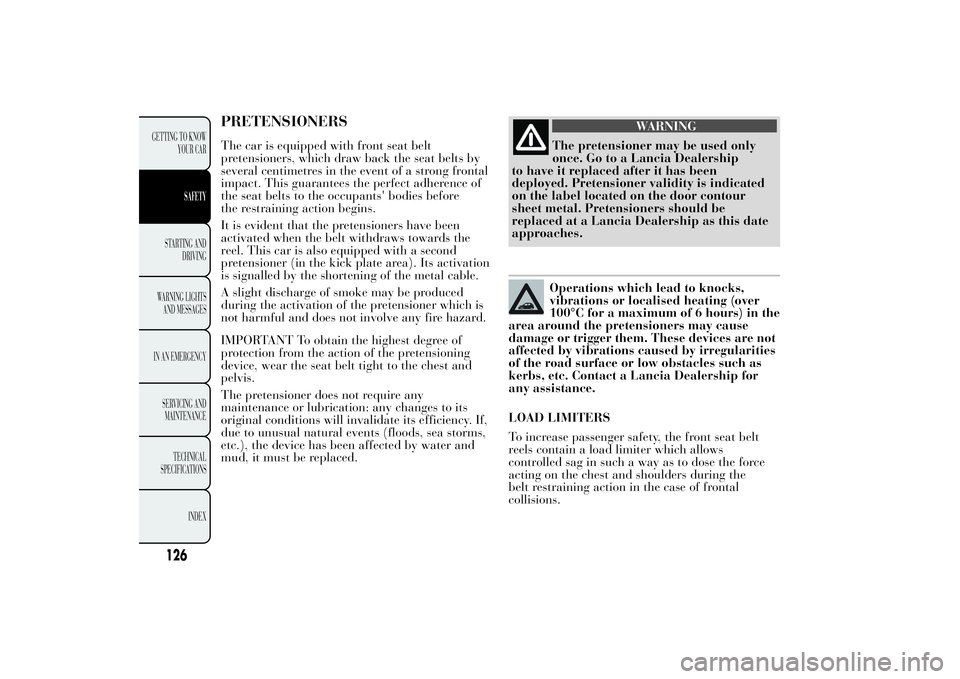
PRETENSIONERSThe car is equipped with front seat belt
pretensioners, which draw back the seat belts by
several centimetres in the event of a strong frontal
impact. This guarantees the perfect adherence of
the seat belts to the occupants' bodies before
the restraining action begins.
It is evident that the pretensioners have been
activated when the belt withdraws towards the
reel. This car is also equipped with a second
pretensioner (in the kick plate area). Its activation
is signalled by the shortening of the metal cable.
A slight discharge of smoke may be produced
during the activation of the pretensioner which is
not harmful and does not involve any fire hazard.
IMPORTANT To obtain the highest degree of
protection from the action of the pretensioning
device, wear the seat belt tight to the chest and
pelvis.
The pretensioner does not require any
maintenance or lubrication: any changes to its
original conditions will invalidate its efficiency. If,
due to unusual natural events (floods, sea storms,
etc.), the device has been affected by water and
mud, it must be replaced.
WARNING
The pretensioner may be used only
once. Go to a Lancia Dealership
to have it replaced after it has been
deployed. Pretensioner validity is indicated
on the label located on the door contour
sheet metal. Pretensioners should be
replaced at a Lancia Dealership as this date
approaches.Operations which lead to knocks,
vibrations or localised heating (over
100°C for a maximum of 6 hours) in the
area around the pretensioners may cause
damage or trigger them. These devices are not
affected by vibrations caused by irregularities
of the road surface or low obstacles such as
kerbs, etc. Contact a Lancia Dealership for
any assistance.
LOAD LIMITERS
To increase passenger safety, the front seat belt
reels contain a load limiter which allows
controlled sag in such a way as to dose the force
acting on the chest and shoulders during the
belt restraining action in the case of frontal
collisions.
126
GETTING TO KNOW
YOUR CAR
SAFETY
STARTING AND
DRIVING
WARNING LIGHTS
AND MESSAGES
IN AN EMERGENCY
SERVICING AND
MAINTENANCE
TECHNICAL
SPECIFICATIONS
INDEX
Page 147 of 307
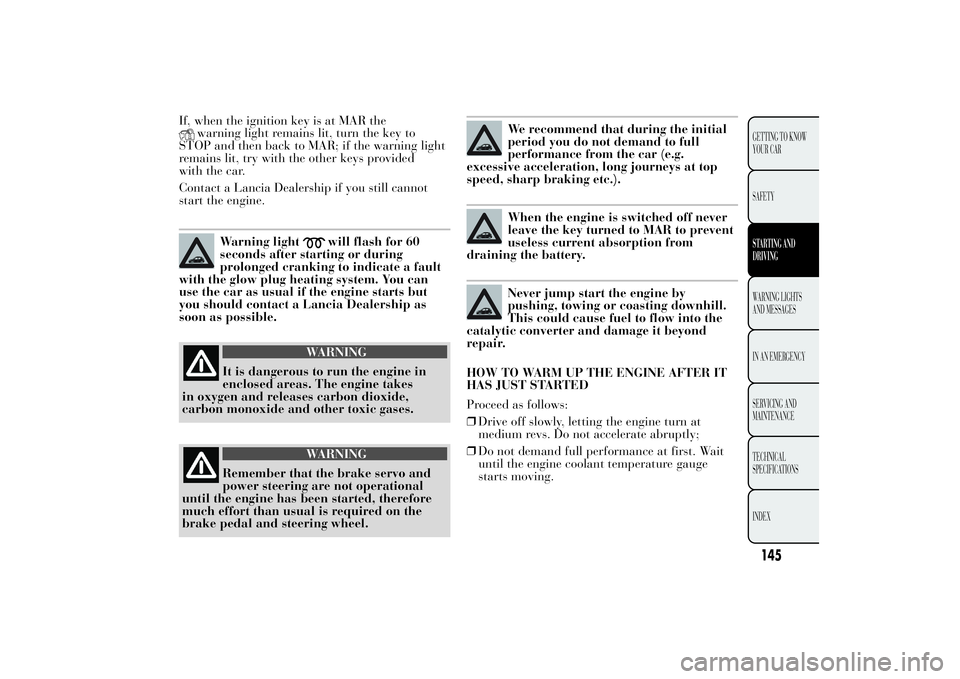
If, when the ignition key is at MAR the
warning light remains lit, turn the key to
STOP and then back to MAR; if the warning light
remains lit, try with the other keys provided
with the car.
Contact a Lancia Dealership if you still cannot
start the engine.
Warning light
will flash for 60
seconds after starting or during
prolonged cranking to indicate a fault
with the glow plug heating system. You can
use the car as usual if the engine starts but
you should contact a Lancia Dealership as
soon as possible.
WARNING
It is dangerous to run the engine in
enclosed areas. The engine takes
in oxygen and releases carbon dioxide,
carbon monoxide and other toxic gases.
WARNING
Remember that the brake servo and
power steering are not operational
until the engine has been started, therefore
much effort than usual is required on the
brake pedal and steering wheel.
We recommend that during the initial
period you do not demand to full
performance from the car (e.g.
excessive acceleration, long journeys at top
speed, sharp braking etc.).When the engine is switched off never
leave the key turned to MAR to prevent
useless current absorption from
draining the battery.Never jump start the engine by
pushing, towing or coasting downhill.
This could cause fuel to flow into the
catalytic converter and damage it beyond
repair.
HOW TO WARM UP THE ENGINE AFTER IT
HAS JUST STARTED
Proceed as follows:
❒Drive off slowly, letting the engine turn at
medium revs. Do not accelerate abruptly;
❒Do not demand full performance at first. Wait
until the engine coolant temperature gauge
starts moving.
145GETTING TO KNOW
YOUR CAR
SAFETYSTARTING AND
DRIVINGWARNING LIGHTS
AND MESSAGES
IN AN EMERGENCY
SERVICING AND
MAINTENANCE
TECHNICAL
SPECIFICATIONS
INDEX
Page 152 of 307
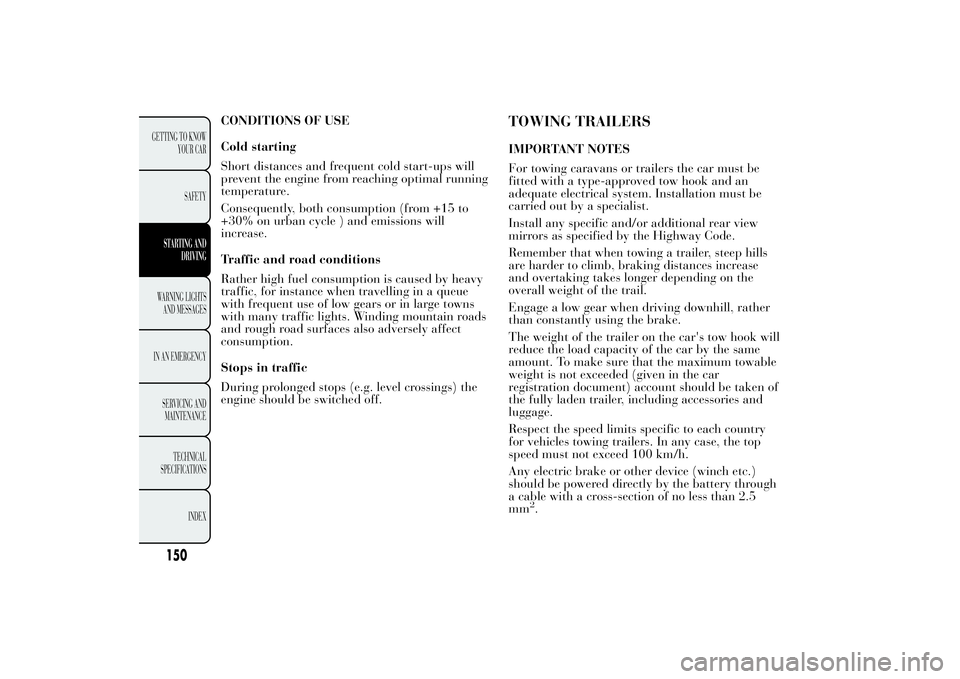
CONDITIONS OF USE
Cold starting
Short distances and frequent cold start-ups will
prevent the engine from reaching optimal running
temperature.
Consequently, both consumption (from +15 to
+30% on urban cycle ) and emissions will
increase.
Traffic and road conditions
Rather high fuel consumption is caused by heavy
traffic, for instance when travelling in a queue
with frequent use of low gears or in large towns
with many traffic lights. Winding mountain roads
and rough road surfaces also adversely affect
consumption.
Stops in traffic
During prolonged stops (e.g. level crossings) the
engine should be switched off.
TOWING TRAILERSIMPORTANT NOTES
For towing caravans or trailers the car must be
fitted with a type-approved tow hook and an
adequate electrical system. Installation must be
carried out by a specialist.
Install any specific and/or additional rear view
mirrors as specified by the Highway Code.
Remember that when towing a trailer, steep hills
are harder to climb, braking distances increase
and overtaking takes longer depending on the
overall weight of the trail.
Engage a low gear when driving downhill, rather
than constantly using the brake.
The weight of the trailer on the car's tow hook will
reduce the load capacity of the car by the same
amount. To make sure that the maximum towable
weight is not exceeded (given in the car
registration document) account should be taken of
the fully laden trailer, including accessories and
luggage.
Respect the speed limits specific to each country
for vehicles towing trailers. In any case, the top
speed must not exceed 100 km/h.
Any electric brake or other device (winch etc.)
should be powered directly by the battery through
a cable with a cross-section of no less than 2.5
mm
2.
150
GETTING TO KNOW
YOUR CAR
SAFETY
STARTING AND
DRIVINGWARNING LIGHTS
AND MESSAGES
IN AN EMERGENCY
SERVICING AND
MAINTENANCE
TECHNICAL
SPECIFICATIONS
INDEX
Page 153 of 307

In addition to the electrical branches, the car's
electrical system can be connected only to the
supply cable for an electric brake and to the cable
for an internal trailer light, though not more
than 15 W. To connect, use the preset control unit
with a battery cable with cross-section no less
than 2.5 mm
2.
IMPORTANT The use of auxiliary loads other
than external lights (electric brake, winch, etc.)
must occur with engine running.
IMPORTANT To install a tow hook contact a
Lancia Dealership.
WARNING
The ABS with which the car may be
equipped will not control the braking
system of the trailer. Particular caution is
required on slippery roads.
WARNING
Never modify the braking system of
the car to control the trailer brake.
The trailer braking system must be fully
independent of the car’s hydraulic system.
SNOW TYRESUse snow tyres of the same size as the normal
tyres provided with the car.
A Lancia Dealership will be happy to provide
advice concerning the most suitable type of tyre
for the customer's requirements.
For the type of tyre to be used, inflation pressures
and the specifications of snow tyres, follow the
instructions given in paragraph "Wheels" in
section "Technical specifications".
The winter performance of these tyres is
considerably reduced when the tread thickness is
less than 4 mm. Replace them in this case.
Due to their specific features, the performance of
snow tyres is much lower than that of normal
types in normal conditions or long motorway
stretches. Their usage should therefore be
restricted in accordance with their type approval.
IMPORTANT When using snow tyres with a
maximum speed index below the one that can be
reached by the car (increased by 5%), place a
notice in the passenger compartment, plainly in
view, which states the maximum speed allowed by
the snow tyres (as per EC Directive).
All four tyres should be the same (brand and
track) to ensure greater safety when driving and
braking and better driveability. Remember that
you should not change the rotation direction of the
tyres.
151GETTING TO KNOW
YOUR CAR
SAFETYSTARTING AND
DRIVINGWARNING LIGHTS
AND MESSAGES
IN AN EMERGENCY
SERVICING AND
MAINTENANCE
TECHNICAL
SPECIFICATIONS
INDEX
Page 160 of 307

2. Engine oil deteriorated
(only Diesel versions with DPF)
The warning light will flash and a specific
message will appear on the display (in versions/
markets, where provided). The warning light may
flash in the following ways, depending on the
version:
❒1 minute every two hours;
❒cycles of 3 minutes with intervals with the
warning light off for 5 seconds until the oil
is changed.
After the first indication, at each engine start up
the warning light will continue flashing as
described above until the oil is changed. For
(versions/markets where provided), the display
shows a dedicated message together with the
warning light.
The flashing of the warning light should not be
considered as a fault, it simply informs the
customer that the oil needs to be changed
following normal car use.Remember that the deterioration of the engine oil
is accelerated by:
❒mainly town use of the car which makes the
DPF regeneration process more frequent;
❒use of the car for short drives, in which the
engine does not have time to reach its regular
operating temperature;
❒repeated interruption of the regeneration
process, signalled by the DPF warning light
coming on.
WARNING
If the warning light comes on, the
exhausted engine oil should be
changed as soon as possible; never drive
more than 500 km from the first
switching-on of this warning light. Failure to
observe the above may result in severe
damage to the engine and invalidate the
warranty. Remember that when the warning
light comes on, it does not mean that the
level of engine oil is low, so if the light
flashes you do not need to top up the engine
oil.
158
GETTING TO KNOW
YOUR CAR
SAFETY
STARTING AND
DRIVINGWARNING LIGHTS
AND MESSAGESIN AN EMERGENCY
SERVICING AND
MAINTENANCE
TECHNICAL
SPECIFICATIONS
INDEX
Page 161 of 307
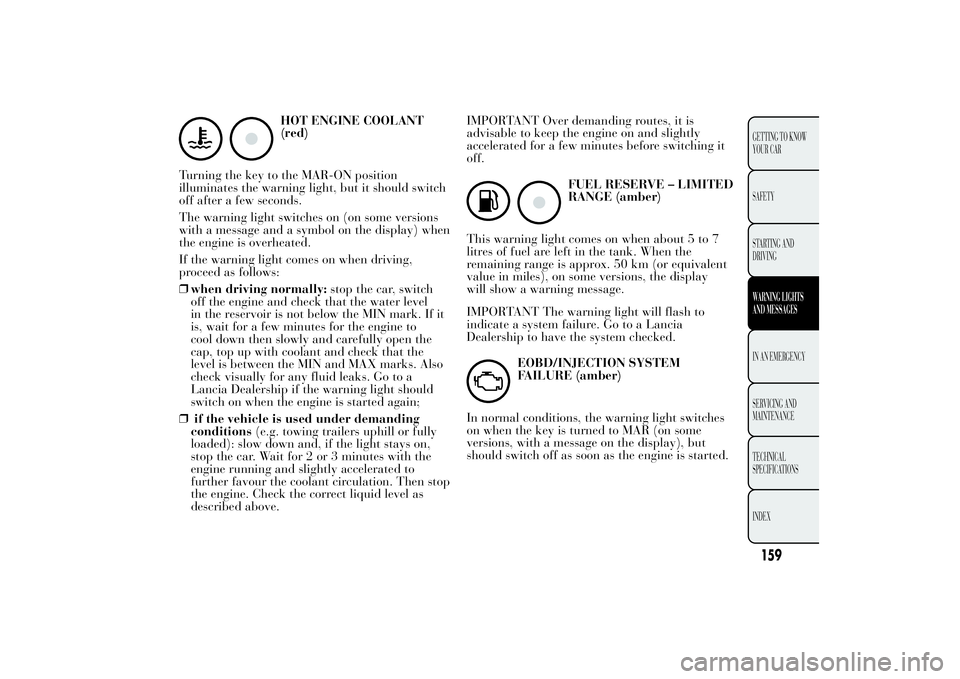
HOT ENGINE COOLANT
(red)
Turning the key to the MAR-ON position
illuminates the warning light, but it should switch
off after a few seconds.
The warning light switches on (on some versions
with a message and a symbol on the display) when
the engine is overheated.
If the warning light comes on when driving,
proceed as follows:
❒when driving normally:stop the car, switch
off the engine and check that the water level
in the reservoir is not below the MIN mark. If it
is, wait for a few minutes for the engine to
cool down then slowly and carefully open the
cap, top up with coolant and check that the
level is between the MIN and MAX marks. Also
check visually for any fluid leaks. Go to a
Lancia Dealership if the warning light should
switch on when the engine is started again;
❒if the vehicle is used under demanding
conditions(e.g. towing trailers uphill or fully
loaded): slow down and, if the light stays on,
stop the car. Wait for 2 or 3 minutes with the
engine running and slightly accelerated to
further favour the coolant circulation. Then stop
the engine. Check the correct liquid level as
described above.IMPORTANT Over demanding routes, it is
advisable to keep the engine on and slightly
accelerated for a few minutes before switching it
off.
FUEL RESERVE – LIMITED
RANGE (amber)
This warning light comes on when about 5 to 7
litres of fuel are left in the tank. When the
remaining range is approx. 50 km (or equivalent
value in miles), on some versions, the display
will show a warning message.
IMPORTANT The warning light will flash to
indicate a system failure. Go to a Lancia
Dealership to have the system checked.
EOBD/INJECTION SYSTEM
FAILURE (amber)
In normal conditions, the warning light switches
on when the key is turned to MAR (on some
versions, with a message on the display), but
should switch off as soon as the engine is started.
159GETTING TO KNOW
YOUR CAR
SAFETY
STARTING AND
DRIVINGWARNING LIGHTS
AND MESSAGESIN AN EMERGENCY
SERVICING AND
MAINTENANCE
TECHNICAL
SPECIFICATIONS
INDEX
Page 171 of 307
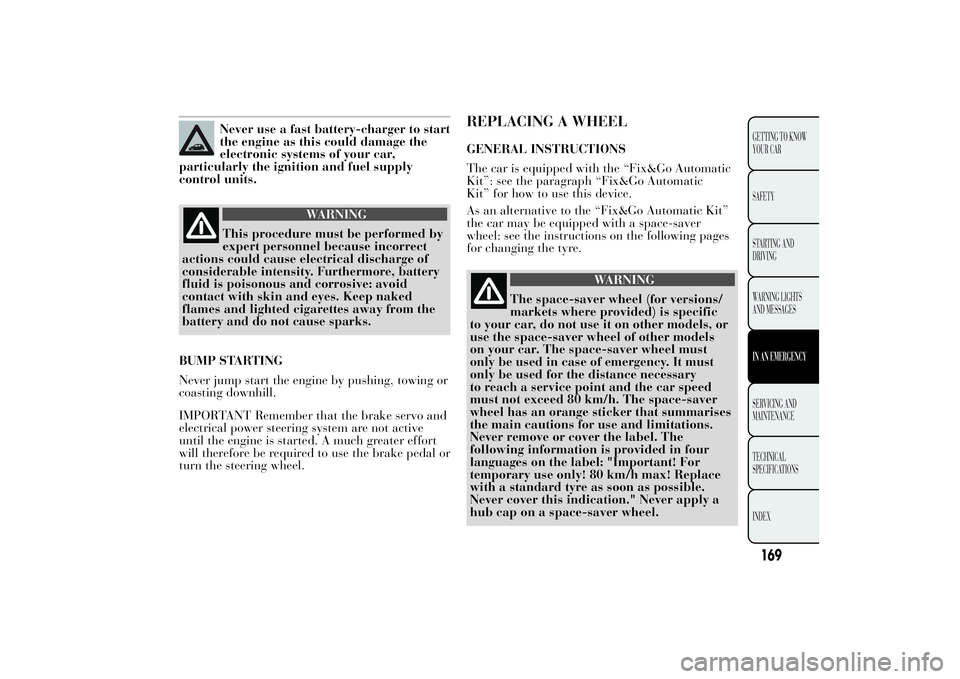
Never use a fast battery-charger to start
the engine as this could damage the
electronic systems of your car,
particularly the ignition and fuel supply
control units.
WARNING
This procedure must be performed by
expert personnel because incorrect
actions could cause electrical discharge of
considerable intensity. Furthermore, battery
fluid is poisonous and corrosive: avoid
contact with skin and eyes. Keep naked
flames and lighted cigarettes away from the
battery and do not cause sparks.
BUMP STARTING
Never jump start the engine by pushing, towing or
coasting downhill.
IMPORTANT Remember that the brake servo and
electrical power steering system are not active
until the engine is started. A much greater effort
will therefore be required to use the brake pedal or
turn the steering wheel.
REPLACING A WHEELGENERAL INSTRUCTIONS
The car is equipped with the “Fix&Go Automatic
Kit”: see the paragraph “Fix&Go Automatic
Kit” for how to use this device.
As an alternative to the “Fix&Go Automatic Kit”
the car may be equipped with a space-saver
wheel: see the instructions on the following pages
for changing the tyre.
WARNING
The space-saver wheel (for versions/
markets where provided) is specific
to your car, do not use it on other models, or
use the space-saver wheel of other models
on your car. The space-saver wheel must
only be used in case of emergency. It must
only be used for the distance necessary
to reach a service point and the car speed
must not exceed 80 km/h. The space-saver
wheel has an orange sticker that summarises
the main cautions for use and limitations.
Never remove or cover the label. The
following information is provided in four
languages on the label: "Important! For
temporary use only! 80 km/h max! Replace
with a standard tyre as soon as possible.
Never cover this indication." Never apply a
hub cap on a space-saver wheel.
169GETTING TO KNOW
YOUR CAR
SAFETY
STARTING AND
DRIVING
WARNING LIGHTS
AND MESSAGESIN AN EMERGENCYSERVICING AND
MAINTENANCE
TECHNICAL
SPECIFICATIONS
INDEX
Page 176 of 307
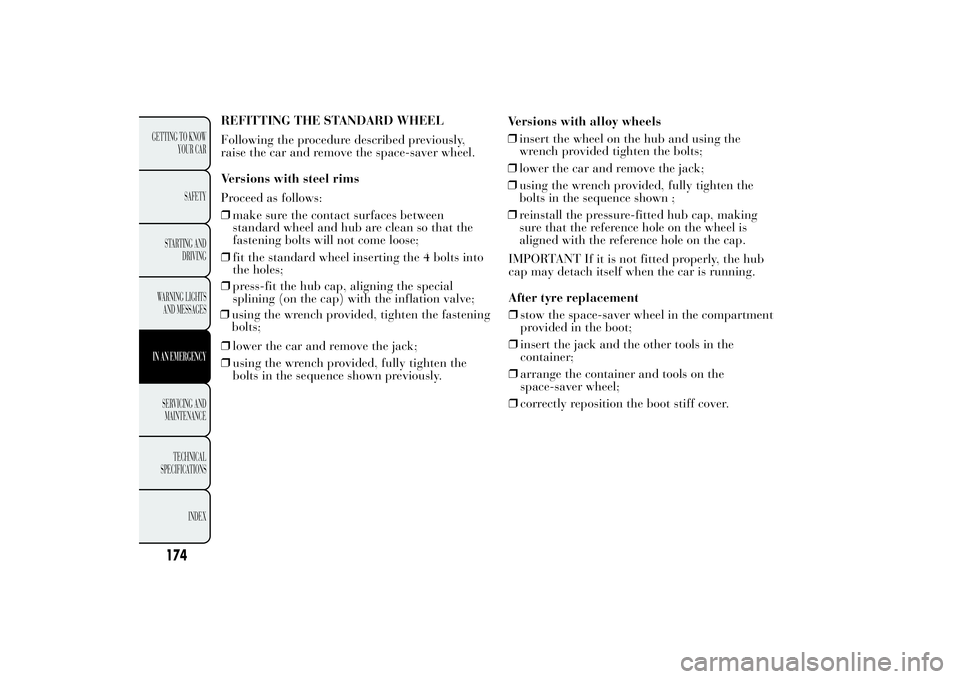
REFITTING THE STANDARD WHEEL
Following the procedure described previously,
raise the car and remove the space-saver wheel.
Versions with steel rims
Proceed as follows:
❒make sure the contact surfaces between
standard wheel and hub are clean so that the
fastening bolts will not come loose;
❒fit the standard wheel inserting the 4 bolts into
the holes;
❒using the wrench provided, tighten the fastening
bolts; ❒press-fit the hub cap, aligning the special
splining (on the cap) with the inflation valve;
❒lower the car and remove the jack;
❒using the wrench provided, fully tighten the
bolts in the sequence shown previously.Versions with alloy wheels
❒insert the wheel on the hub and using the
wrench provided tighten the bolts;
❒lower the car and remove the jack;
❒using the wrench provided, fully tighten the
bolts in the sequence shown ;
❒reinstall the pressure-fitted hub cap, making
sure that the reference hole on the wheel is
aligned with the reference hole on the cap.
IMPORTANT If it is not fitted properly, the hub
cap may detach itself when the car is running.
After tyre replacement
❒stow the space-saver wheel in the compartment
provided in the boot;
❒insert the jack and the other tools in the
container;
❒arrange the container and tools on the
space-saver wheel;
❒correctly reposition the boot stiff cover.
174
GETTING TO KNOW
YOUR CAR
SAFETY
STARTING AND
DRIVING
WARNING LIGHTS
AND MESSAGESIN AN EMERGENCYSERVICING AND
MAINTENANCE
TECHNICAL
SPECIFICATIONS
INDEX
Page 177 of 307

"Fix&Go Automatic" kitIt is located in a special container in the luggage
compartment fig. 121. The container also contains
a screwdriver and the tow hook.
The kit fig. 122 contains:
❒a bottle A fig. 122 containing sealer and fitted
with:
❒filling pipe B;
❒sticker C bearing the notice “max. 80 km/h”, to
be placed in a position visible to the driver (on
the instrument panel) after fixing the tyre;
❒a compressor D including a pressure gauge and
connections, found in the compartment;❒instruction brochure (see fig. 123), to be used
for prompt and correct use of the tyre quick
repair kit and then to be handed to the
personnel charged with handling the treated
tyre;
❒a pair of protective gloves located in the side
compartment of the compressor;
❒adapters for inflating different elements.
WARNING
Give the instructions brochure to the
technicians who will be handling
the tyre that was repaired using the tyre
quick repair kit.
fig. 121
L0F0093
fig. 122
L0F0006
175GETTING TO KNOW
YOUR CAR
SAFETY
STARTING AND
DRIVING
WARNING LIGHTS
AND MESSAGESIN AN EMERGENCYSERVICING AND
MAINTENANCE
TECHNICAL
SPECIFICATIONS
INDEX